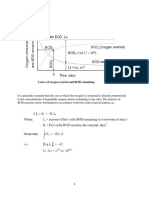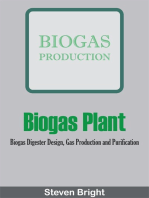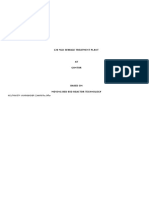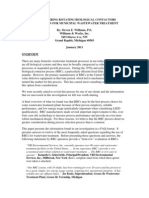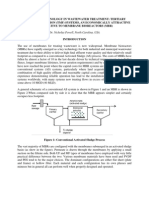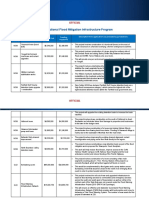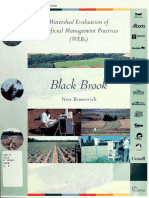Applying The: Taking Care of The World's Water
Uploaded by
Bon BonApplying The: Taking Care of The World's Water
Uploaded by
Bon BonTaking care of the worlds water.
APPLYING THE ROTATING BIOLOGICAL CONTACTOR PROCESS
DESCRIPTION OF THE RBC PROCESS
The Rotating Biological Contactor (RBC) process is one of the more efficient fixed film wastewater treatment technologies. As such, it is well-suited for secondary and/or advanced treatment in municipal or industrial applications.
RADIAL PASSAGES 35-40% SUBMERGENCE
U P TO
The process consists of large diameter steel or corrugated plastic media cen-
Biomass thickness ranges from 0.030 inch (0.75 mm) to 0.125 inch (3 mm) depending upon organic concentration, temperature and other process variables. The RBC process demonstrated long term reliability in the 1970s. Today, more than 6,000 units are operating. Benefits of the process include:
s Consistent process results s Stable operation frequent supervi-
CONCENTRIC PASSAGES
12 FT .D IA M ET ER
tered around a horizontal shaft, placed in a concrete tank. The media is slowly rotated (mechanical or air drive). At any given time during the rotation, about 40% of the media surface area is in the wastewater. Organisms in the wastewater attach and multiply on the rotating media until
CENTRAL STEEL SHAFT OPTIONAL SUPPLEMENTAL AIR HEADER
CONVENTIONAL RBC PROCESS
they form a thin layer of biomass. This shaggy, fixed film growth presents a very large, very active population for the biological degradation of organic pollutants.
sion not required; microbial population accommodates organic and hydraulic fluctuations
s Lower expansion and retrofit costs
Front Cover: This 32 shaft air-driven RBC installation uses high density media, allowing it to provide more treatment on fewer assemblies.
During rotation, the media carries the biomass and a film of wastewater into the air where oxygen is absorbed. The dissolved oxygen and organic materials in the wastewater diffuse into the biomass and are then metabolized. Radial and concentric passages in the media allow unrestricted entry of the wastewater and air throughout the units total surface area for continued growth of the biomass. Excess biomass shears off at a steady rate as the media rotates. These solids are
modular construction, reduced excavation costs
s Smaller footprint due to short waste-
water retention time
s Minimal headloss through system s Very low energy consumption on
the order of 3 kW per 3,000 people
s Minimal maintenance simple drive
and bearing lubrication
s Reduced life cycle costs as compared
to suspended growth systems
s Simple operation no recycle, less lab
testing for process control
s Operator friendly
Biomass is evenly distributed over the media surface.
carried through the RBC system for subsequent removal in a conventional clarifier.
2.
A P P L I C AT I O N S F O R T H E R B C P R O C E S S
In new construction, the RBC process can accommodate flows ranging from 15,000 gpd to over 30 MGD. It is applied for organic carbon removal (BOD), nitrification, denitrification, or various combinations. It is compatible as well with applications requiring phosphorous removal. Typical applications are:
s Municipal wastewater treatment
Process water used by one of the worlds largest gold mines is treated by this USFilter RBC plant.
s Refinery and petrochemical waste-
s Food and beverage wastewater treat-
water treatment
s Pulp and paper wastewater treatment s Septage treatment s Many general industrial wastewaters
ment including meat packing, bakery, dairy, brewery
s Landfill leachate
Series 300 RBCs have served this 27 MGD plant for more than 10 years.
In nitrification upgrades for existing secondary treatment facilities, the RBC process can provide the required capacity in limited space. For any treatment plant expansion, the systems small footprint makes it advantageous, especially where space is at a premium. In many retrofit applications, RBC units can be easily customized to fit existing rectangular basins and to accommodate increased flow capacities by adding or modifying the media configuration. Due to equipment design, the RBC system can be assembled on site or in a building. In upgrading trickling filter plants,
Typical corrugated RBC media.
parallel or series with the existing system, for additional capacity or improved treatment levels. Usually, additional clarifiers are not required, and because of the RBC processs low head loss, further pumping can usually be avoided. The process equipment is available with a mechanical drive; with a mechanical drive and supplemental air; or with an air drive only. Media is available as standard, medium or high density. A conventional RBC with low density media, 25 feet long by 12 feet in diameter, offers over 110,000 square feet of media surface area. High density units provide over 165,000 square feet of fixed film surface.
3.
the RBC process can be installed in either
R B C P R O C E S S O P E R AT I O N S
After primary treatment, the effluent flows to a multi-stage RBC process where fixed aerobic cultures absorb the dissolved organic matter from the wastewater. Part of the absorbed organic matter is oxidized into carbon dioxide and water, and part is synthesized into additional biomass.
RBC UNITS PRIMARY TREATMENT
Each stage of media operates as a
SECONDARY CLARIFIER
The RBC process is operated on a once-through basis with no need for recycle of effluent. There is also no need for a sludge recycle, since the attached biofilm is continuously growing. The absence of recycle requirements provides for simple process operation. The use of simple drive components and media configurations results in very low energy and maintenance requirements.
completely mixed, fixed film biological reactor in which there is a dynamic equilibrium between the rate of biological growth and stripped biomass. As the wastewater passes from stage to stage, it undergoes a progressively increasing degree of treatment by the different biological cultures that develop in the successive stages.
RAW WASTE
EFFLUENT
SOLIDS DISPOSAL
CONVENTIONAL RBC PROCESS FLOW SCHEMATIC
BIOMASS RESPONDS TO ORGANIC CONCENTRATION
The initial stages of media, for example, receive the highest concentration of organic matter and develop cultures of mixed heterotropic bacteria. As the concentration of organics decreases in later stages, nitrifying bacteria begin to appear along with various types of higher life forms such as protozoa, rotifers and other predators. The stripped biomass and bioflocculated suspended matter leave the last process stage along with the treated wastewater and flow to a secondary clarifier where the solids are separated for disposal. Clarified effluent passes on for disinfection or further treatment. Settled solids
This is an example of the thinness of the fixed film biomass growth.
Molded fiberglass covers are recommended and are furnished with the units. Covers minimize the area to be enclosed and eliminate the need for operator entrance. They also prevent debris accumulation, prevent algae growth on the media, and provide process temperature control. Buildings can be constructed, but generally, the fiberglass enclosure alone has been the more cost effective choice.
A major RBC installation is installed at a regional resort area near a major metropolitan city. Discharge is into an environmentally sensitive waterway.
thicken to 2.5 to 3.0%; 4 to 5% if combined with primary solids.
4.
R B C P R O C E S S D E S I G N C O N S I D E R AT I O N S
Design considerations for the RBC process have been established through extensive pilot plant testing and years of operating experience. Although a number of factors are taken into account, including media rotational speed, tank volume, residence time, etc., the primary design factors are:
s Substrate Removal Kinetics. Raw
100 mg/l or less; and can be easily treated by the RBC process. For most applications, the main effort associated with process design and equipment selection is to determine the surface area requirement for the biomass.
s Organic Loading. Systems installed
municipal wastewater contains about 1/3 soluble BOD, 1/3 settleable BOD and 1/3 suspended BOD; after primary clarification, the ratio is 1/2 soluble and 1/2 suspended BOD. Industrial wastewaters can contain 50 to 100% soluble BOD.
NO SLUDGE RECYCLE
effectively treat high strength wastes such as industrial wastes or septage.
Because there is no sludge recycle and These efficient, shock resistant syssince suspended solids remain in the tems often work where suspended RBC reactor for such a short period of growth systems are eliminated. time (one to two hours), the oxygen demand of suspended solids is very degrees F, the treatment efficiency of low. As a result, soluble BOD is the the RBC process decreases for carbon controlling design parameter. and nitrogen control. For northern cliThe principle mechanism of treatment (substrate removal) in the RBC process is the diffusion of soluble matter into the biomass, where it is metabolized. Suspended matter in the wastewater and sheared biomass have no effect on the rate of soluble subTE
s Wastewater Temperature. Below 55
mates, supplied covers prevent major heat loss from the wastewater.
% BOD REMOVAL
MP
ER
AT U
RE
=5
This RBC plant can be provided with supplemental air to reduce maintenance and energy requirements.
strate diffusion, and therefore do not affect removal levels.
s Hydraulic Loading. Most domestic
TEMP
URE ERAT
GPD/FT2
wastewater and many industrial effluents have soluble BOD levels of
RBC PROCESS PARAMETER WASTEWATER TEMPERATURE
5.
R B C P R O C E S S V S A C T I VAT E D S L U D G E
Both the RBC and activated sludge processes utilize similar biological cultures and can produce high degrees of treatment. The major difference is that over 95% of the RBC processs biological solids are attached to the media. And that leads to the following differences:
s Process Stability: Activated sludge
trol. Due to its modular construction, low hydraulic head loss and shallow excavations, the process is comparatively easy to upgrade and expand.
s Maintenance and Power Con-
requires efficient solids settling and adequate biosolids recycling for satisfactory operation. Hydraulic surges and organic shock loads also can cause prolonged upsets. The RBC process
RBCs are insalled around the world because of their simple and economical operation.
sumption: These two items are the most attractive features of the RBC process when compared to the activated sludge process. RBC energy consumption is approximately 25% of the activated sludge requirement.
s Ease of Nitrification: The RBC
does not require recycling, and because the biomass is attached to the media, it is not affected by clarifier washouts or shock loadings. RBCs handle diurnal peak flows of 2.5:1 without process adjustment.
s Manpower: The relatively simple
process can achieve any degree of nitrification with only a single settling tank and without sludge recycle. Activated sludge plants usually require far more elaborate treatment stages to achieve nitrification.
s Sludge Characteristics: Sludges
operation of the RBC process leads to significant manpower savings, estimated at one-half when compared to
RBC DESIGN IS EASY TO UPGRADE
the activated sludge system.
s Flexibility: Periods of low flow are
troublesome to activated sludge plants. Also, because of the processs size requirements, expansions and upgrades are difficult/costly. RBC facilities, on the other hand, when loaded less than design, typically achieve excellent effluents without additional con-
produced by the RBC process settle well, permitting shallower secondary clarifiers designed for higher overflow rates. Activated sludges are prone to settling problems, and require a compaction zone for sludge recycling, leading to larger clarifiers.
6.
R B C P R O C E S S VA R I AT I O N S
For upgrades, retrofits and expansions, the Surfact Process provides more treatment without requiring additional space, by installing a fixed film RBC (or SBC) system in an existing activated sludge tank. Alternatively, incorporating sludge recycle into an existing RBC process at some installations can achieve similar results.
s The Surfact Process: BOD removal
combined with the air-drive rotation of the SBC has dramatic economic and operating benefits. This big brother to the RBC, with media diameter up to 5.5 meters, also has over twice the surface area per unit. For a typical application (compared to RBCs, activated sludge, etc.), fewer SBCs and less land are required; energy costs are low; and maintenance hours are relatively insignificant. Process benefits of the SBC include long term operational stability, effective biofilm control and odor control.
s Solids Contact: A derivative of the
and nitrification in a single treatment step,
The Surfact Process increases capacity and minimizes construction costs for either new or upgrade applications.
and an increase in treatment capacity ranging from 50% to 150%. Converting to the Surfact Process is attractive because treatment capacity can be increased quite economically since the hybrid, combined system provides additional biomass and also offers bionutri-
SURFACT PROCESS REDUCES TOTAL AIR REQUIREMENTS
ent removal capability. The slow rotation of the RBC unit greatly augments oxygen transfer into the suspended growth such that total air requirements with Surfact are significantly reduced. In some cases, as much as a 50% reduction in air requirements (and costs) is realized. Installation of an RBC system into existing aeration basins usually requires
Surfact Process; incorporates sludge recycle to the last RBC stage. The process increases suspended solids capture in the secondary clarifier by bioflocculating the sloughed biomass with the recycled solids, yielding a clear effluent.
s Primary treatment upgrades: Large
50% EXPOSURE TO ATMOSPHERE ADD-ON MEDIA PACKS RADIAL PASSAGE AIR CAPTURE CUPS PROCESS AIR HEADER
only minor concrete modifications and
85% SUBMERGENCE
the addition of a few support girders. Existing air diffusers and the rotation of the RBC unit normally supply the necessary aeration to the biofilm. However, supplemental air can be added if required.
s SBC process: The Submerged Biologi-
rectangular primary clarifiers can be upgraded by installing RBCs in the upper portion of the tank. The result combines secondary treatment and clarification in existing tankage. Benefits include significant savings on construction costs by eliminating the need for additional clarifiers and maximizing available land.
SUBMERGED BIOLOGICAL CONTACTOR
DRIVE AIR HEADER
cal Contactor process operates in a deep tank with 70% to 90% of the media immersed in wastewater (vs 40% for a typical RBC unit). The increased submergence
The SBC Process represents state-of-the-art RBC technology.
7.
R E P L A C E M E N T PA R T S F O R M O S T R B C s
USFilter offers a wide range of replacement parts for its RBC systems and for systems manufactured by others. Please consult us for obsolete manufacturers units, as the capability exists to retrofit stock items to obsolete designs to keep the units running smoothly. Most are in stock with nextday shipment available.
Components include:
s Media Packs s Air cups s Bearings s Supplemental air assemblies s Coarse bubble diffusers s Fine bubble diffusers s Reducers, drive components s Hydraulic and electronic load cell kits s Shaft lifting devices s Fiberglass covers
PILOT TESTING
PACKAGE PLANTS
Complete package plants designed to your effluent requirements are available. They include primary treatment, RBC secondary treatment, secondary clarifiers, tertiary filtration and disinfection, as appropriate. Turnkey installations can be provided for subdivisions, housing complexes, hotels and commercial buildings. Package plants range in size from 15,000 GPD to 150,000 GPD.
Bench and full scale pilot units are available to test performance of a typical wastestream or to verify a particular application. Units are completely selfcontained, ready for hookup to wastewater and effluent supply lines.
Standard package plants are available in a wide range of sizes and can be shipped worldwide.
To find out more about how to put USFilter to work for you, contact us at:
Taking care of the worlds water.
Envirex Products P.O. Box 1604 Waukesha, WI 53187 414.547.0141 phone 414.547.4120 fax
Bulletin No. USF 315-13A6 5M-10/98 Printed in the U.S.A.
http://www.usfilter.com
1998 United States Filter Corporation
You might also like
- Topic 4.2 BOD Model and Oxygen Sag CurveNo ratings yetTopic 4.2 BOD Model and Oxygen Sag Curve17 pages
- CAP 15 - 3 Design of Water Resource Recovery Facilities, Sixth Edition Nitrogen-Removal-Sidestream-Process-DesignNo ratings yetCAP 15 - 3 Design of Water Resource Recovery Facilities, Sixth Edition Nitrogen-Removal-Sidestream-Process-Design4 pages
- How Industrial Businesses Can Reduce Production Costs With Reverse Osmosis: Industrial Reverse OsmosisFrom EverandHow Industrial Businesses Can Reduce Production Costs With Reverse Osmosis: Industrial Reverse Osmosis5/5 (2)
- Biogas Plant: Biogas Digester Design, Gas Production and PurificationFrom EverandBiogas Plant: Biogas Digester Design, Gas Production and PurificationNo ratings yet
- 120 MLD Sewage Treatment Plant: NCL/TMX/STP-VIKARABAD/BP-2244/R0/Tec OfferNo ratings yet120 MLD Sewage Treatment Plant: NCL/TMX/STP-VIKARABAD/BP-2244/R0/Tec Offer39 pages
- Anaerobic Processes: Rate Systems. Thus One Can Have A Low-Rate, Suspended-Growth Anaerobic System WhichNo ratings yetAnaerobic Processes: Rate Systems. Thus One Can Have A Low-Rate, Suspended-Growth Anaerobic System Which6 pages
- Tubular Sidestream (Cross Flow) MBR Applications For Industrial EffluentsNo ratings yetTubular Sidestream (Cross Flow) MBR Applications For Industrial Effluents6 pages
- Reconsidering Rotating Biological ContactorsNo ratings yetReconsidering Rotating Biological Contactors11 pages
- Treatment of Industrial Wastewater by Membrane BioreactorsNo ratings yetTreatment of Industrial Wastewater by Membrane Bioreactors10 pages
- 77 Two Stage Uasb Treatment of Industrial Wastewater With Internal Circulation100% (1)77 Two Stage Uasb Treatment of Industrial Wastewater With Internal Circulation10 pages
- Microsoft Powerpoint - Technical Presentation On Bio-TowersNo ratings yetMicrosoft Powerpoint - Technical Presentation On Bio-Towers19 pages
- Biological Treatment of Waste Water: V.Sampath Kumar Reddy100% (1)Biological Treatment of Waste Water: V.Sampath Kumar Reddy25 pages
- OTC-27746-MS cMIST™: Novel, Compact Dehydration System For Reducing Size and WeightNo ratings yetOTC-27746-MS cMIST™: Novel, Compact Dehydration System For Reducing Size and Weight14 pages
- With Membrane Technolgy For Oil Sands and Power Generation ApplicationsNo ratings yetWith Membrane Technolgy For Oil Sands and Power Generation Applications8 pages
- An Li - Biological Wastewater Treatment - Selecting The ProcessNo ratings yetAn Li - Biological Wastewater Treatment - Selecting The Process6 pages
- FEASIBILITY REPORT FOR 4.25 MLD RO BASED EFFLUENT RECYCLE SYSTEMNo ratings yetFEASIBILITY REPORT FOR 4.25 MLD RO BASED EFFLUENT RECYCLE SYSTEM17 pages
- Compilation of Sewage Treatment Technologies in BangladeshNo ratings yetCompilation of Sewage Treatment Technologies in Bangladesh11 pages
- ASML - Techincal Proposal For Grey Water TreatmentNo ratings yetASML - Techincal Proposal For Grey Water Treatment7 pages
- Use of The Upflow Sludge Blanket (USB) ReactorNo ratings yetUse of The Upflow Sludge Blanket (USB) Reactor36 pages
- Addis Ababa Science and Technology University100% (1)Addis Ababa Science and Technology University7 pages
- Wastewater Leachate Treatment TechnologiesNo ratings yetWastewater Leachate Treatment Technologies3 pages
- Port Neches Groves ISD No267 Huntsman Petrochemical LLC Supplemental MaterialNo ratings yetPort Neches Groves ISD No267 Huntsman Petrochemical LLC Supplemental Material15 pages
- Amendment No6 To 30 MLD SWRO LSTK TenderNo ratings yetAmendment No6 To 30 MLD SWRO LSTK Tender2 pages
- Review Literature On Wetland Ecosystem of AssamNo ratings yetReview Literature On Wetland Ecosystem of Assam4 pages
- How To Save Water: Install A Well in GhanaNo ratings yetHow To Save Water: Install A Well in Ghana2 pages
- Allen, Laura - Greywater, Green Landscape - How To Install Simple Water-Saving Irrigation Systems in Your Yard-Storey Publishing (2017) - 8No ratings yetAllen, Laura - Greywater, Green Landscape - How To Install Simple Water-Saving Irrigation Systems in Your Yard-Storey Publishing (2017) - 820 pages
- Introduction To Environmental Engineering-Sources of WatersupplyNo ratings yetIntroduction To Environmental Engineering-Sources of Watersupply138 pages
- Unpacking The Cape Town Drought: Lessons Learned: March 2019No ratings yetUnpacking The Cape Town Drought: Lessons Learned: March 201930 pages
- Cet306 Design of Hydraulic Structures, June 2023No ratings yetCet306 Design of Hydraulic Structures, June 20233 pages
- CAP 15 - 3 Design of Water Resource Recovery Facilities, Sixth Edition Nitrogen-Removal-Sidestream-Process-DesignCAP 15 - 3 Design of Water Resource Recovery Facilities, Sixth Edition Nitrogen-Removal-Sidestream-Process-Design
- How Industrial Businesses Can Reduce Production Costs With Reverse Osmosis: Industrial Reverse OsmosisFrom EverandHow Industrial Businesses Can Reduce Production Costs With Reverse Osmosis: Industrial Reverse Osmosis
- Biogas Plant: Biogas Digester Design, Gas Production and PurificationFrom EverandBiogas Plant: Biogas Digester Design, Gas Production and Purification
- 120 MLD Sewage Treatment Plant: NCL/TMX/STP-VIKARABAD/BP-2244/R0/Tec Offer120 MLD Sewage Treatment Plant: NCL/TMX/STP-VIKARABAD/BP-2244/R0/Tec Offer
- Anaerobic Processes: Rate Systems. Thus One Can Have A Low-Rate, Suspended-Growth Anaerobic System WhichAnaerobic Processes: Rate Systems. Thus One Can Have A Low-Rate, Suspended-Growth Anaerobic System Which
- Tubular Sidestream (Cross Flow) MBR Applications For Industrial EffluentsTubular Sidestream (Cross Flow) MBR Applications For Industrial Effluents
- Treatment of Industrial Wastewater by Membrane BioreactorsTreatment of Industrial Wastewater by Membrane Bioreactors
- 77 Two Stage Uasb Treatment of Industrial Wastewater With Internal Circulation77 Two Stage Uasb Treatment of Industrial Wastewater With Internal Circulation
- Microsoft Powerpoint - Technical Presentation On Bio-TowersMicrosoft Powerpoint - Technical Presentation On Bio-Towers
- Biological Treatment of Waste Water: V.Sampath Kumar ReddyBiological Treatment of Waste Water: V.Sampath Kumar Reddy
- OTC-27746-MS cMIST™: Novel, Compact Dehydration System For Reducing Size and WeightOTC-27746-MS cMIST™: Novel, Compact Dehydration System For Reducing Size and Weight
- With Membrane Technolgy For Oil Sands and Power Generation ApplicationsWith Membrane Technolgy For Oil Sands and Power Generation Applications
- An Li - Biological Wastewater Treatment - Selecting The ProcessAn Li - Biological Wastewater Treatment - Selecting The Process
- FEASIBILITY REPORT FOR 4.25 MLD RO BASED EFFLUENT RECYCLE SYSTEMFEASIBILITY REPORT FOR 4.25 MLD RO BASED EFFLUENT RECYCLE SYSTEM
- Compilation of Sewage Treatment Technologies in BangladeshCompilation of Sewage Treatment Technologies in Bangladesh
- ASML - Techincal Proposal For Grey Water TreatmentASML - Techincal Proposal For Grey Water Treatment
- Waste Management in the Chemical and Petroleum IndustriesFrom EverandWaste Management in the Chemical and Petroleum Industries
- How Reverse Osmosis Works: A Look at Industrial ROFrom EverandHow Reverse Osmosis Works: A Look at Industrial RO
- A.I.S.: Arterial Infrastructure System PresentationFrom EverandA.I.S.: Arterial Infrastructure System Presentation
- Port Neches Groves ISD No267 Huntsman Petrochemical LLC Supplemental MaterialPort Neches Groves ISD No267 Huntsman Petrochemical LLC Supplemental Material
- Allen, Laura - Greywater, Green Landscape - How To Install Simple Water-Saving Irrigation Systems in Your Yard-Storey Publishing (2017) - 8Allen, Laura - Greywater, Green Landscape - How To Install Simple Water-Saving Irrigation Systems in Your Yard-Storey Publishing (2017) - 8
- Introduction To Environmental Engineering-Sources of WatersupplyIntroduction To Environmental Engineering-Sources of Watersupply
- Unpacking The Cape Town Drought: Lessons Learned: March 2019Unpacking The Cape Town Drought: Lessons Learned: March 2019

